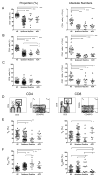Long-term effects of alemtuzumab on regulatory and memory T-cell subsets in kidney transplantation
- PMID: 22343334
- PMCID: PMC3323763
- DOI: 10.1097/TP.0b013e318247a717
Long-term effects of alemtuzumab on regulatory and memory T-cell subsets in kidney transplantation
Abstract
Background: Induction with lymphocyte-depleting antibodies is routinely used to prevent rejection but often skews T cells toward memory. It is not fully understood which memory and regulatory T-cell subsets are most affected and how they relate to clinical outcomes.
Methods: We analyzed T cells from 57 living-donor renal transplant recipients (12 reactive and 45 quiescent) 2.8±1.4 years after alemtuzumab induction. Thirty-four healthy subjects and nine patients with acute cellular rejection (ACR) were also studied.
Results: We found that alemtuzumab caused protracted CD4 more than CD8 T-lymphocyte deficiency, increased proportion of CD4 memory T cells, and decreased proportion of CD4 regulatory T cells. Reactive patients exhibited higher proportions of CD4 effector memory T cells (TEM) and CD8 terminally differentiated TEM (TEMRA), with greater CD4 TEM and CD8 TEMRA to regulatory T cell ratios, than quiescent patients or healthy controls. Patients with ongoing ACR had profound reduction in circulating CD8 TEMRA. Mixed lymphocyte assays showed significantly lower T-cell proliferation to donor than third-party antigens in the quiescent group, while reactive and ACR patients exhibited increased effector molecules in CD8 T cells.
Conclusions: Our findings provide evidence that T-cell skewing toward TEM may be associated with antigraft reactivity long after lymphodepletion. Further testing of TEM and TEMRA subsets as rejection predictors is warranted.
Conflict of interest statement
All authors declare no conflict of interest.
Figures




Similar articles
-
Longitudinal analysis of T and B cell phenotype and function in renal transplant recipients with or without rituximab induction therapy.PLoS One. 2014 Nov 13;9(11):e112658. doi: 10.1371/journal.pone.0112658. eCollection 2014. PLoS One. 2014. PMID: 25393622 Free PMC article. Clinical Trial.
-
Homeostatic repopulation by CD28-CD8+ T cells in alemtuzumab-depleted kidney transplant recipients treated with reduced immunosuppression.Am J Transplant. 2008 Feb;8(2):338-47. doi: 10.1111/j.1600-6143.2007.02078.x. Am J Transplant. 2008. PMID: 18211507
-
Elevation of CD4+ differentiated memory T cells is associated with acute cellular and antibody-mediated rejection after liver transplantation.Transplantation. 2013 Jun 27;95(12):1512-20. doi: 10.1097/TP.0b013e318290de18. Transplantation. 2013. PMID: 23619734
-
Rapamycin Prevents Expansion of Costimulation Blockade-resistant CD8+ Alloreactive Memory Cells following Depletional Induction in Renal Transplant Recipients.J Immunol. 2024 Nov 1;213(9):1305-1317. doi: 10.4049/jimmunol.2400146. J Immunol. 2024. PMID: 39302088 Free PMC article.
-
Postdepletion Lymphocyte Reconstitution During Belatacept and Rapamycin Treatment in Kidney Transplant Recipients.Am J Transplant. 2016 Feb;16(2):550-64. doi: 10.1111/ajt.13469. Epub 2015 Oct 5. Am J Transplant. 2016. PMID: 26436448 Free PMC article.
Cited by
-
Phase I study of alemtuzumab for therapy of steroid-refractory chronic graft-versus-host disease.Biol Blood Marrow Transplant. 2013 May;19(5):804-11. doi: 10.1016/j.bbmt.2013.02.009. Epub 2013 Feb 14. Biol Blood Marrow Transplant. 2013. PMID: 23416855 Free PMC article. Clinical Trial.
-
B-cell response in solid organ transplantation.Front Immunol. 2022 Aug 9;13:895157. doi: 10.3389/fimmu.2022.895157. eCollection 2022. Front Immunol. 2022. PMID: 36016958 Free PMC article. Review.
-
Homeostatic expansion as a barrier to lymphocyte depletion strategies.Curr Opin Organ Transplant. 2014 Aug;19(4):357-62. doi: 10.1097/MOT.0000000000000096. Curr Opin Organ Transplant. 2014. PMID: 24926701 Free PMC article. Review.
-
CD4+CD25+ T regulatory cells in renal transplantation.Front Immunol. 2022 Nov 8;13:1017683. doi: 10.3389/fimmu.2022.1017683. eCollection 2022. Front Immunol. 2022. PMID: 36426347 Free PMC article. Review.
-
Enhancing the Value of Histopathological Assessment of Allograft Biopsy Monitoring.Transplantation. 2019 Jul;103(7):1306-1322. doi: 10.1097/TP.0000000000002656. Transplantation. 2019. PMID: 30768568 Free PMC article. Review.
References
-
- Cai J, Terasaki PI. Induction Immunosuppression Improves Long-Term Graft and Patient Outcome in Organ Transplantation: An Analysis of United Network for Organ Sharing Registry Data. Transplantation. 2010;90:1511. - PubMed
-
- Meier-Kriesche H-U, Li S, Gruessner RWG, et al. Immunosuppression: evolution in practice and trends, 1994–2004. Am J Transplant. 2006;6 (5 Pt 2):1111. - PubMed
-
- Kirk AD. Induction immunosuppression. Transplantation. 2006;82 (5):593. - PubMed
-
- Margreiter R, Klempnauer J, Neuhaus P, Muehlbacher F, Boesmueller C, Calne RY. Alemtuzumab (Campath-1H) and tacrolimus monotherapy after renal transplantation: results of a prospective randomized trial. Am J Transplant. 2008;8 (7):1480. - PubMed
-
- Kaufman DB, Leventhal JR, Gallon LG, Parker MA. Alemtuzumab induction and prednisone-free maintenance immunotherapy in simultaneous pancreas-kidney transplantation comparison with rabbit antithymocyte globulin induction - long-term results. Am J Transplant. 2006;6 (2):331. - PubMed
Publication types
MeSH terms
Substances
Grants and funding
LinkOut - more resources
Full Text Sources
Other Literature Sources
Medical
Research Materials

